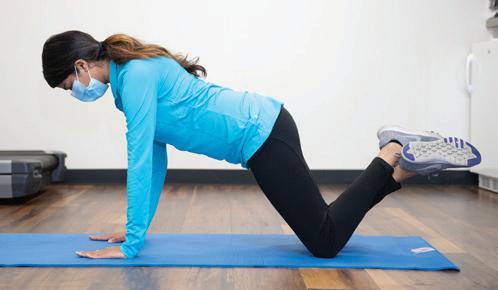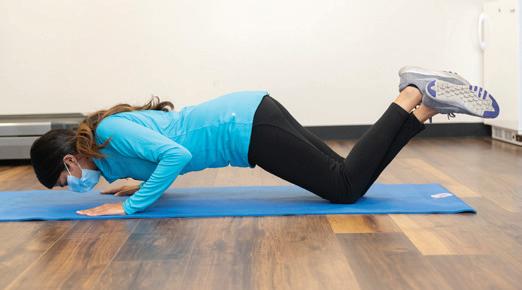
5 minute read
EXERCISING AT HOME
EXERCISING AT HOME: HOW TO GET STARTED
EXERCISE CAN EASE MINOR PAINS CAUSED BY A TOO-SEDENTARY LIFESTYLE.
Have you experienced a recent onset of neck, shoulder, back, knee or ankle pain? If you’re one of the many who are now working from home—or who are staying at home more for pandemic-related reasons—your reduced level of mobility may be the cause.
If that’s the case, scheduling an inperson or telehealth visit with a physical therapist (PT) for a screening is a good first step, advises Puja Desai, PT, DPT, Supervisor of Sports Medicine and Orthopedic Physical Therapy at Saint Barnabas Medical Center Sports Medicine and Orthopedic Rehabilitation at the JCC MetroWest. (In New Jersey, most insurances will cover an evaluation by a PT without a doctor’s prescription; check your plan to be sure.)
“As a part of a thorough physical therapy evaluation, your past medical history will be reviewed and you will be screened for possible red flags, such as an underlying medical condition,” says Desai. “If there’s cause for concern, you’ll be referred back to your primary care physician.” In other cases, a personalized course of treatment with a PT may be the
REHABILITATION DESTINATIONS
When you need a physical rehabilitation program customized to your needs by a highly trained professional, Saint Barnabas Medical Center offers four convenient locations for outpatient physical and occupational therapy.
Comprehensive Rehabilitation Center at the Barnabas Health Ambulatory Care Center
200 South Orange Avenue, Livingston; 973.322.7500
Saint Barnabas Medical Center Outpatient Physical Rehabilitation Center in Millburn
120 Millburn Avenue, Suite 206, Millburn; 973.921.0480
Saint Barnabas Medical Center Sports Medicine and Orthopedic Rehabilitation at the JCC MetroWest
760 Northfield Avenue, Suite 210A, West Orange; 973.325.9100
Saint Barnabas Pediatric Occupational and Physical Therapy, West Orange
375 Mount Pleasant Avenue, West Orange; 973.969.3434
For more information about rehabilitation services at Saint Barnabas Medical Center, call 973.322.7500 or visit www.rwjbh.org/sbmcrehab.
recommended option.
If, on the other hand, you are cleared for an at-home exercise regimen, that practice can improve your life in many ways. “Patients who have a regular exercise routine have more energy, strength and mobility, and reduced risk of developing various health conditions, such as Type 2 diabetes and heart disease,” says Desai.
Desai recommends the exercise routine on these pages, which can be done from warm-up to cooldown in under a half hour to begin. “This routine provides a good balance of strength and cardio work for a full-body workout. It can be performed by beginners and be done at home with limited space,” she says. “Also, the exercises don’t require any special equipment. They use body weight to challenge the individual.”
When you are ready to increase intensity, increase repetitions first. For example, perform the exercise for 45 seconds instead of 30 and progress toward 60 seconds.
Once this is not challenging, add weights for the following exercises: posterior lunge, weighted squat and lateral lunge. Use household items, such as a gallon of water or a heavy textbook for the exercises demonstrated with a medicine ball in the photos. Desai’s instructions include the all-important cues—for example, “core engaged, chest high”—that are required for proper form.
One caution: If any of the exercises causes discomfort or pain, stop the exercise and reach out to your PT or primary care physician.
WARM-UP
Use large movements to promote blood flow throughout your body to ready it for the workout. Perform each exercise for 30 seconds, resting for 10 seconds between each exercise. Do this circuit three to five times. High Knees (or standing march for a low-impact option): With feet hip-width apart, lift your left knee to your chest, then your right knee. Alternate this movement and keep posture upright and core engaged throughout. Calf Raises: Stand up straight, push through the balls of your feet, so that your heels are off the ground, and slowly lower back to the floor. Keep your core engaged and your posture upright. Active Knee Flexion with Side-to-Side Shuffle: Step side to side while bending your knee so that your heel gets closer to your buttocks. Lateral step with butt kicks.
CARDIO
a 15-second break in between. Perform three suggested in warm-up
STRENGTH
Perform each exercise for 30–45 seconds, 15–20 seconds of rest in between. Perform three rounds of each circuit. Take breaks as needed throughout.

Modified Triceps Push
ups (at left): Keep elbows tucked to the sides of your body, parallel to your chest.
Plank: Place forearms on floor, elbows aligned below shoulders and arms parallel to your body at shoulder width. Form a straight line from your head to your heels. Engage core, tighten glutes (buttocks muscles).
Mountain Climber (at left): Moving in a engaged and try to keep your hips level and parallel to the floor. Bring one knee toward your chest, avoid curving your lower back. Hold for a second and then alternate with the opposite knee.
Weighted Lateral Lunge (above): Keep your hips back, core engaged, chest high. Hold weight close to body at chest level.
Posterior Lunge with Overhead Press (at
left): Slow controlled movement, steady knees, abs/core engaged. Make sure knee and toes are in line. You can use water bottles, a gallon of water, a textbook or other household item as a weight.
Weighted Squat with Calf Raise (above): Beginners should try this exercise with a stable/sturdy chair behind them at first. If using a weight, keep it close to your body. Make sure your knees do not pass your toes, keep your chest high and core engaged. End with a calf raise.
Perform each exercise for 30 to 45 seconds, with rounds. Jumping Jacks: selfcontrolled pace. High Knees (same as those slow and controlled way, keep your core
exercises). Lateral Shuffles: step side to side, self-controlled pace.
ACTIVE COOLDOWN
Low-intensity aerobic activity prevents blood pooling in limbs. Active cooldowns also allow controlled and gradual decrease in heart rate and blood pressure. Perform a combination of the following and cool down for about 5 to 10 minutes. Side-to-side Shuffle for 30 seconds Marching in Place for 30 seconds Forward Bend, seated with legs outstretched; hold for 10 seconds, perform 3 times Walk for 5 to 10 minutes










